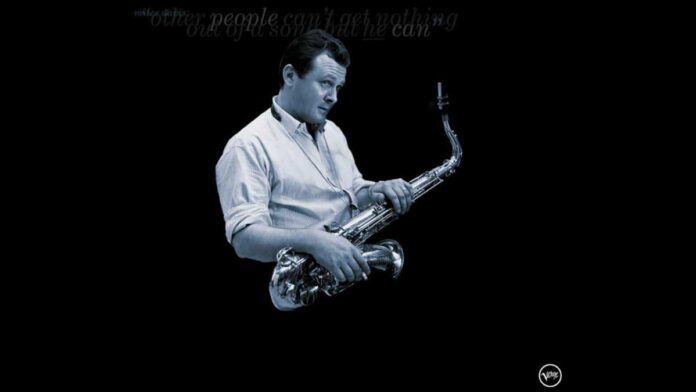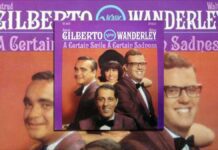Stan Getz was once described as “a great bunch of guys” due to his many moods. Fortunately for us, one of them loved Bossa Nova.
Bossa Nova’s American Icon, Stan Getz recorded five Bossa Nova albums in two years, plus the definitive version of The Girl From Ipanema. Let’s look back with some insight from another musical legend.
Did you happen to catch Quincy Jones’ comments on pop music the other day? In an interview with GQ, he took aim at Taylor Swift’s pop success by saying “We need songs, not hooks”.
And when challenged with the notion that Swift is considered by many as one of the top songwriters of the day, he observed. “A great song can make the worst singer in the world a star. A bad song can’t be saved by the three best singers in the world. I learned that 50 years ago.”
Jones had trouble with Elvis Presley too (“He couldn’t sing”…), but I doubt that he’d have much to complain about with Brazil’s greatest songwriter, Antonio Carlos Jobim. Or Joao Gilberto, the man who invented the Bossa Nova rhythm during a self-imposed exile to the Brazilian countryside.
Even Astrud Gilberto has been graced with musical immortality… and a great song. These things are beyond doubt, even for Quincy Jones.
But in Bossa Nova’s story, saxophonist Stan Getz was the wild card and an unlikely flagbearer as Bossa Nova’s American icon.
His talent was obvious, having become a professional musician with Woody Herman’s’ band at 16, only three years after picking up a saxophone for the first time. Drug arrests and drinking problems dotted his career, leading to a move to Europe to avoid prosecution.
But, Getz knew how to create lasting music. He recorded five Bossa Nova albums in about two years, including the definitive version of Bossa Nova’s most famous song.
Despite the magnificent truth of the music captured during those recordings, it was not a natural fit for the saxophonist. There are other stories that I won’t share here, because the sum of these creative parts made the difference for Getz and Bossa Nova.
Jazz Samba
First up was 1962’s Jazz Samba with guitarist Charlie Byrd, who had returned from Rio de Janeiro as part of a goodwill concert tour of Latin America with Brazil’s new sound percolating in his head. Relocated to the US only recently after years of living in Europe, Getz was invited into the project but had little understanding of the music he was about to record.
Byrd had turned him on to the Bossa sound with a record by Joao Gilberto a few weeks prior. “I immediately feel in love with it… Charlie had been trying to sell a record of it with I don’t know how many companies, but none of ‘em wanted it. What they needed was the voice – the horn.”
And timing. The quick success of Jazz Samba ignited the Bossa Nova craze in the US and in 13 months, Getz went on to record four more Bossa Nova albums, cementing his status as Bossa Nova’s American icon.
If Jazz Samba is not in your collection, it should be.
Date with Destiny
In 1960, Creed Taylor had just opened the new Verve Records label and had already met Jobim and many of Bossa’s top names during trips to Brazil. He arranged an introductory meeting between Stan Getz, Jobim and João Gilberto in the rehearsal studio at Carnegie Hall, only a few days after the legendary Bossa Nova concert there.
They discussed the idea of recording an album together and the notion began to simmer with Taylor, who was already turning Bossa Nova into a US pop success with Jazz Samba.
“It wasn’t as loose as it could have been, because there weren’t any Brazilians involved and the players didn’t quite understand that behind-the-beat style that was this thing called Bossa Nova,” recalled Taylor, in an interview with David Simons of ‘Acoustic Guitar’. “In fact, that cowbell figure on ‘Desafinado’ drove me nuts! But I thought the tunes were real catchy, even if that stiffness was, oddly enough, the original attraction. And it just opened the door for that wave of Brazilian talent.”
When Taylor assembled his Brazilian stars in wintry New York at the “dingy but effective’ A&R studio in March of 1963, his vision for ‘Getz/Gilberto’ was clear in his mind and he chose Jobim’s music to showcase his new style.
So. Whose idea was it?
Call it myth, legend or truth, who really knows? But what happened in that cramped studio between that group of gifted musicians was unique.
And the question of how ‘Garota de Ipanema’ became ‘The Girl From Ipanema’?
The popular version goes like this: Stan Getz (or Creed Taylor) heard Astrud and Joao Gilberto singing quietly in the corner of the studio during a session break and invited her to sing on two tracks, in English.
Another version has Getz lobbying hard for Astrud’s participation, against the wishes of Jobim and Joao. Astrud strongly states that it was Joao’s idea completely, while Jobim’s favorite Brazilian journalist Ruy Castro writes in his book Bossa Nova, that the Gilberto’s had been hatching the idea together since the first day of recording, practicing in their New York hotel room.
But however the decision was made, the result was an historic one.
Getz/Gilberto
If you still have concerns about Stan Getz as Bossa Nova’s American icon. a tap on the shoulder from this album should ease your mind.
Few pop albums of any kind have matched its success. Getz/Gilberto was nominated for seven Grammys in 1964, coming away with four awards (for Record of the Year, Album of the Year, Best Instrumental Jazz Performance – Small Group, and Best Engineered Record – nonclassical) edging out both Barbra Streisand and the Beatles.
The album entered the Grammy Hall of Fame in 1999 and ‘The Girl From Ipanema’ single followed a year later. It turned Astrud and Getz into pop stars and brought fame and fortune to Antonio Carlos Jobim and Joao Gilberto.
For his part, Getz plays at his lyrical best with each solo improvisation as eloquent and well-structured as to make it effortless to follow every note. In fact, his tenor sax solos have been committed to memory by hundreds of thousands of fans that whistle or hum along with them at ease.
Big Changes
The success of ‘Getz/Gilberto’ created big changes for its major players. With his earnings, Stan Getz bought a New York mansion. He would soon put his Bossa Nova era behind him, forever to remain a high-water mark in his long career.
It’s said that Astrud Gilberto was paid on the standard union rate of $120 dollars for her work, but those who focus on this seeming injustice fail to recognize the opportunity that she created for herself: She immediately decided to tour with Stan Getz and continued to develop her singing career with Creed Taylor. For Bossa Nova fans, she became the ‘Girl from Ipanema’.
Joao Gilberto stayed on in New York with two Grammy awards, but without his soon-to-be ex-wife. Jobim also made New York his ‘on and off’ home, splitting time between the US and Brazil by recording and touring until he came to the attention of Frank Sinatra a few years later.
Creed Taylor reaped the success of those seven Grammy nominations in 1964 when he was approached by Herb Alpert and Jerry Moss of A&M Records and asked to consider a partnership. The result was the creation of Creed Taylor’s own label, CTI Records. The new label’s first release? Antonio Carlos Jobim’s Wave.
Back to the Block
It’s easy to understand how Quincy Jones’ comments above ring true. The song is the thing. And if there is a single thread to pull on throughout his Bossa Nova recordings, it’s that Stan Getz knew this instinctively.
Bossa Nova celebrated its 60th year in 2018 and it’s not by chance that this musical milestone is a big deal. Worldwide, Bossa Nova is as authentic and enduring a song style as rock or jazz. Fans know that Bossa Nova is everything today’s pop music is not.
Just don’t tell Taylor Swift. Please.
Stan Getz: Bossa Nova’s American Icon
Stories like this are what we do. Why don’t you join us?
- Sign up for our emails on music, travel, friends and fun. Listen to our ‘always live’ streaming station and our 12 streaming music channels, always free. Browse our Lifestyle Directory. Click here to like our Facebook page and here for Brazilian events coast to coast.









